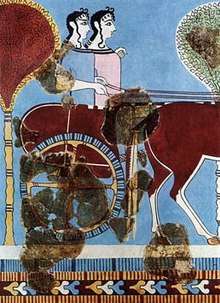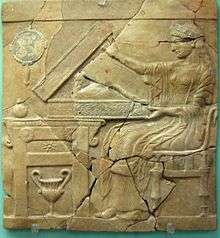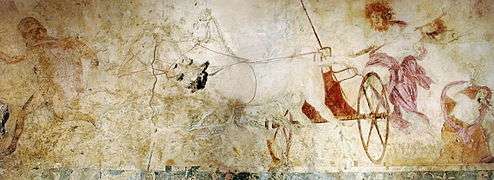Persephone
In Greek mythology, Persephone (/pərˈsɛfəniː/ pər-SEF-ə-nee; Greek: Περσεφόνη), also called Kore (/ˈkɔːriː/ KOR-ee; Greek: Κόρη; "the maiden"), is the daughter of Zeus and Demeter. She became the queen of the underworld through her abduction by Hades, the god of the underworld.[1] The myth of her abduction represents her function as the personification of vegetation, which shoots forth in spring and withdraws into the earth after harvest; hence, she is also associated with spring as well as the fertility of vegetation. Similar myths appear in the cults of male gods like Attis, Adonis, and Osiris,[2] and in Minoan Crete.
| Persephone | |
|---|---|
Goddess of the underworld, springtime, flowers and vegetation | |
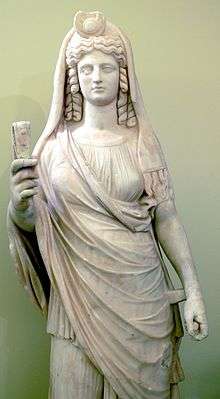 | |
| Abode | The Underworld, Sicily, Mount Olympus |
| Symbol | Pomegranate, Seeds of Grain, Torch, Flowers and Deer |
| Personal information | |
| Parents | Zeus and Demeter, Zeus and Rhea (Orphic) |
| Siblings | Aeacus, Angelos, Aphrodite, Apollo, Ares, Arion, Artemis, Athena, Chrysothemis, Despoina, Dionysus, Eileithyia, Enyo, Eris, Ersa, Eubuleus, Hebe, Helen of Troy, Hephaestus, Heracles, Hermes, Minos, Pandia, Philomelus, Plutus, Perseus, Rhadamanthus, the Graces, the Horae, the Litae, the Muses, the Moirai |
| Spouse | Hades |
| Children | Melinoe, Plutus, Dionysus (Orphic) Zagreus |
| Roman equivalent | Proserpina (Proserpine) |
Persephone as a vegetation goddess and her mother Demeter were the central figures of the Eleusinian Mysteries, which promised the initiated a more enjoyable prospect after death. In some versions, Persephone is the mother of Zeus' son Dionysus, (or Iacchus, and/or Zagreus, as a result of their identification with Dionysus). The origins of her cult are uncertain, but it was based on ancient agrarian cults of agricultural communities.
Persephone was commonly worshipped along with Demeter and with the same mysteries. To her alone were dedicated the mysteries celebrated at Athens in the month of Anthesterion. In Classical Greek art, Persephone is invariably portrayed robed, often carrying a sheaf of grain. She may appear as a mystical divinity with a sceptre and a little box, but she was mostly represented in the process of being carried off by Hades.
Her name has numerous historical variants. These include Persephassa (Περσεφάσσα) and Persephatta (Περσεφάττα). In Latin her name is rendered Proserpina. She was identified by the Romans as the Italic goddess Libera.
Name
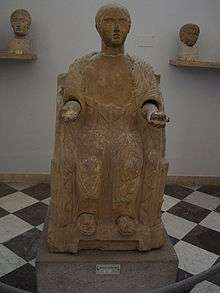
In a Linear B Mycenaean Greek inscription on a tablet found at Pylos dated 1400–1200 BC, John Chadwick reconstructed[n 1] the name of a goddess, *Preswa who could be identified with Persa, daughter of Oceanus and found speculative the further identification with the first element of Persephone.[4][5] Persephonē (Greek: Περσεφόνη) is her name in the Ionic Greek of epic literature. The Homeric form of her name is Persephoneia (Περσεφονεία,[6] Persephoneia). In other dialects, she was known under variant names: Persephassa (Περσεφάσσα), Persephatta (Περσεφάττα), or simply Korē (Κόρη, "girl, maiden").[7] Plato calls her Pherepapha (Φερέπαφα) in his Cratylus, "because she is wise and touches that which is in motion". There are also the forms Periphona (Πηριφόνα) and Phersephassa (Φερσέφασσα). The existence of so many different forms shows how difficult it was for the Greeks to pronounce the word in their own language and suggests that the name may have a Pre-Greek origin.[8]
Persephatta (Περσεφάττα) is considered to mean "female thresher of grain"; the first constituent of the name originates in Proto-Greek "perso-" (related to Sanskrit "parṣa-"), "sheaf of grain" and the second constituent of the name originates in Proto-Indo European *-gʷn-t-ih, from the root *gʷʰen- "to strike".[9]
A popular folk etymology is from φέρειν φόνον, pherein phonon, "to bring (or cause) death".[10]
Titles and functions
The epithets of Persephone reveal her double function as chthonic (underworld) and vegetation goddess. The surnames given to her by the poets refer to her character as Queen of the lower world and the dead, or her symbolic meaning of the power that shoots forth and withdraws into the earth. Her common name as a vegetation goddess is Kore, and in Arcadia she was worshipped under the title Despoina, "the mistress", a very old chthonic divinity.[10]
Goddess of Spring and Nature
Plutarch writes that Persephone was identified with the spring season[11] and Cicero calls her the seed of the fruits of the fields. In the Eleusinian Mysteries, her return from the underworld each spring is a symbol of immortality, and hence she was frequently represented on sarcophagi.
In the religions of the Orphics and the Platonists, Kore is described as the all-pervading goddess of nature[12] who both produces and destroys everything, and she is therefore mentioned along with or identified as other such divinities including Isis, Rhea, Ge, Hestia, Pandora, Artemis, and Hecate.[13] The Orphic Persephone is said to have become by Zeus the mother of Dionysus, Iacchus, Zagreus,[10] and the little-attested Melinoe.[14]
Goddess of the Underworld
In mythology and literature she is often called dread(ed) Persephone, and queen of the Underworld, within which tradition it was forbidden to speak her name. This tradition comes from her conflation with the very old chthonic divinity Despoina ("[the] mistress"), whose real name could not be revealed to anyone except those initiated into her mysteries.[15] As goddess of death, she was also called a daughter of Zeus and Demeter,[16] the river that formed the boundary between Earth and the underworld. In Homer's epics, she appears always together with Hades and the Underworld, apparently sharing with Hades control over the dead.[17] In Homer's Odyssey, Odysseus encounters the "dread persephone" in Tartarus when he visits his dead mother. Odysseus sacrifices a rams to the cthonic goddes Persephone and the ghosts of the dead who drink the blood of the sacrificed animal. In the reformulation of Greek mythology expressed in the Orphic Hymns, Dionysus and Melinoe are separately called children of Zeus and Persephone.[18] Groves sacred to her stood at the western extremity of the earth on the frontiers of the lower world, which itself was called "house of Persephone".[19]
Her central myth served as the context for the secret rites of regeneration at Eleusis,[20] which promised immortality to initiates.
Nestis
In a Classical period text ascribed to Empedocles, c. 490–430 BC,[n 2] describing a correspondence among four deities and the classical elements, the name Nestis for water apparently refers to Persephone: "Now hear the fourfold roots of everything: enlivening Hera, Hades, shining Zeus. And Nestis, moistening mortal springs with tears."[21]
Of the four deities of Empedocles' elements, it is the name of Persephone alone that is taboo—Nestis is a euphemistic cult title[n 3]—for she was also the terrible Queen of the Dead, whose name was not safe to speak aloud, who was euphemistically named simply as Kore or "the Maiden", a vestige of her archaic role as the deity ruling the underworld. Nestis means "the Fasting One" in ancient Greek.
Epithets
As a goddess of the underworld, Persephone was given euphemistically friendly names.[22] However it is possible that some of them were the names of original goddesses:
- Despoina (dems-potnia) "the mistress" (literally "the mistress of the house") in Arcadia.
- Hagne, "pure", originally a goddess of the springs in Messenia.[23]
- Melindia or Melinoia (meli, "honey"), as the consort of Hades, in Hermione. (Compare Hecate, Melinoe)[22]
- Malivina[22]
- Melitodes[22]
- Aristi cthonia, "the best chthonic".[22]
- Praxidike, the Orphic Hymn to Persephone identifies Praxidike as an epithet of Persephone: "Praxidike, subterranean queen. The Eumenides' source [mother], fair-haired, whose frame proceeds from Zeus' ineffable and secret seeds."[24][25]
As a vegetation goddess, she was called:[23][26]
- Kore, "the maiden".
- Kore Soteira, "the savior maiden", in Megalopolis.
- Neotera, "the younger", in Eleusis.
- Kore of Demeter Hagne in the Homeric hymn.
- Kore memagmeni, "the mixed daughter" (bread).
Demeter and her daughter Persephone were usually called:[26][27]
Mythology
Abduction myth
Persphone's abduction by Hades[n 4] is mentioned briefly in Hesiod's Theogony,[29] and told in considerable detail in the Homeric Hymn to Demeter. Zeus, it is said, permitted Hades, who was in love with the beautiful Persephone, to abduct her as her mother Demeter was not likely to allow her daughter to go down to Hades. Persephone was gathering flowers with the Oceanids along with Artemis and Pallas, daughter of Triton, as the Homeric Hymn says, in a field when Hades came to abduct her, bursting through a cleft in the earth.[30] Demeter, when she found her daughter had disappeared, searched for her all over the earth with Hecate's torches. In most versions she forbids the earth to produce, or she neglects the earth and in the depth of her despair she causes nothing to grow. Helios, the sun, who sees everything, eventually told Demeter what had happened and at length she discovered the place of her abode. Finally, Zeus, pressed by the cries of the hungry people and by the other deities who also heard their anguish, forced Hades to return Persephone.[31]

Hades complies with the request, but first he tricks her, giving her some pomegranate seeds to eat.[32] Hermes, is sent to retrieve her, but because she had tasted the food of the underworld, she was obliged to spend a third of each year (the winter months) there, and the remaining part of the year with the gods above.[33] With the later writers Ovid and Hyginus, Persephone's time in the underworld becomes half the year.[34] It was explained to Demeter, her mother that she would be released, so long as she did not taste the food of the dead.
Various local traditions place Persephone's abduction in a different location. The Sicilians, among whom her worship was probably introduced by the Corinthian and Megarian colonists, believed that Hades found her in the meadows near Enna, and that a well arose on the spot where he descended with her into the lower world. The Cretans thought that their own island had been the scene of the abduction, and the Eleusinians mentioned the Nysian plain in Boeotia, and said that Persephone had descended with Hades into the lower world at the entrance of the western Oceanus. Later accounts place the abduction in Attica, near Athens, or near Eleusis.[31]
.jpg)
The Homeric hymn mentions the Nysion (or Mysion) which was probably a mythical place. The location of this mythical place may simply be a convention to show that a magically distant chthonic land of myth was intended in the remote past.[26] Before Persephone was abducted by Hades, the shepherd Eumolpus and the swineherd Eubuleus saw a girl in a black chariot driven by an invisible driver being carried off into the earth which had violently opened up. Eubuleus was feeding his pigs at the opening to the underworld when Persephone was abducted by Plouton. His swine were swallowed by the earth along with her, and the myth is an etiology for the relation of pigs with the ancient rites in Thesmophoria,[35] and in Eleusis.
In the hymn, Persephone returns and she is reunited with her mother near Eleusis. Demeter as she has been promised established her mysteries (orgies) when the Eleusinians built for her a temple near the spring of Callichorus. These were awful mysteries which were not allowed to be uttered. The uninitiated would spend a miserable existence in the gloomy space of Hades after death.[n 5]
In some versions, Ascalaphus informed the other deities that Persephone had eaten the pomegranate seeds. When Demeter and her daughter were reunited, the Earth flourished with vegetation and color, but for some months each year, when Persephone returned to the underworld, the earth once again became a barren realm. This is an origin story to explain the seasons.
In an earlier version, Hecate rescued Persephone. On an Attic red-figured bell krater of c. 440 BC in the Metropolitan Museum of Art, Persephone is rising as if up stairs from a cleft in the earth, while Hermes stands aside; Hecate, holding two torches, looks back as she leads her to the enthroned Demeter.[36]
The 10th-century Byzantine encyclopedia Suda introduces a goddess of a blessed afterlife assured to Orphic mystery initiates. This Macaria is asserted to be the daughter of Hades, but no mother is mentioned.[37]
Interpretation of the myth
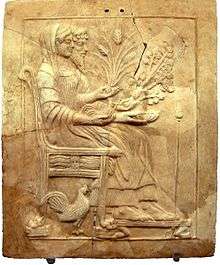
In the myth Pluto abducts Persephone to be his wife and the queen of his realm (this is the myth which explains their marriage).[38] Pluto (Πλούτων, Ploutōn) was a name for the ruler of the underworld; the god was also known as Hades, a name for the underworld itself. The name Pluton was conflated with that of Ploutos (Πλούτος Ploutos, "wealth"), a god of wealth, because mineral wealth was found underground, and because Pluto as a chthonic god ruled the deep earth that contained the seeds necessary for a bountiful harvest.[39] Plouton is lord of the dead, but as Persephone's husband he has serious claims to the powers of fertility.[40]
In the Theogony of Hesiod, Demeter was united with the hero Iasion in Crete and she bore Ploutos.[29] This union seems to be a reference to a hieros gamos (ritual copulation) to ensure the earth's fertility.[40] This ritual copulation appears in Minoan Crete, in many Near Eastern agricultural societies, and also in the Anthesteria.[n 6]
Nilsson believes that the original cult of Ploutos (or Pluto) in Eleusis was similar with the Minoan cult of the "divine child", who died in order to be reborn. The child was abandoned by his mother and then it was brought up by the powers of nature. Similar myths appear in the cults of Hyakinthos (Amyklai), Erichthonios (Athens), and later in the cult of Dionysos.[42]
The Greek version of the abduction myth is related to grain – important and rare in the Greek environment – and the return (ascent) of Persephone was celebrated at the autumn sowing. Pluto (Ploutos) represents the wealth of the grain that was stored in underground silos or ceramic jars (pithoi), during summer months. Similar subterranean pithoi were used in ancient times for burials and Pluto is fused with Hades, the King of the realm of the dead. During summer months, the Greek grain-Maiden (Kore) is lying in the grain of the underground silos in the realm of Hades, and she is fused with Persephone, the Queen of the Underworld. At the beginning of the autumn, when the seeds of the old crop are laid on the fields, she ascends and is reunited with her mother Demeter, for at that time the old crop and the new meet each other. For the initiated, this union was the symbol of the eternity of human life that flows from the generations which spring from each other.[43][44]
Arcadian myths
The primitive myths of isolated Arcadia seem to be related to the first Greek-speaking people who came from the north-east during the Bronze Age. Despoina (the mistress), the goddess of the Arcadian mysteries, is the daughter of Demeter and Poseidon Hippios (horse), who represents the river spirit of the underworld that appears as a horse as often happens in northern-European folklore. He pursues the mare-Demeter and from the union she bears the horse Arion and a daughter who originally had the form or the shape of a mare. The two goddesses were not clearly separated and they were closely connected with the springs and the animals. They were related with the god of rivers and springs; Poseidon and especially with Artemis, the Mistress of the Animals who was the first nymph.[1] According to the Greek tradition a hunt-goddess preceded the harvest goddess.[45] In Arcadia, Demeter and Persephone were often called Despoinai (Δέσποιναι, "the mistresses") in historical times. They are the two Great Goddesses of the Arcadian cults, and evidently they come from a more primitive religion.[26] The Greek god Poseidon probably substituted the companion (Paredros, Πάρεδρος) of the Minoan Great goddess[46] in the Arcadian mysteries.
Worship
Persephone was worshipped along with her mother Demeter and in the same mysteries. Her cults included agrarian magic, dancing, and rituals. The priests used special vessels and holy symbols, and the people participated with rhymes. In Eleusis there is evidence of sacred laws and other inscriptions.[47]
The Cult of Demeter and the Maiden is found at Attica, in the main festivals Thesmophoria and Eleusinian mysteries and in a lot of local cults. These festivals were almost always celebrated at the autumn sowing, and at full-moon according to the Greek tradition. In some local cults the feasts were dedicated to Demeter.
Origins

The myth of a goddess being abducted and taken to the Underworld is probably Pre-Greek in origin. Samuel Noah Kramer, the renowned scholar of ancient Sumer, has posited that the Greek story of the abduction of Persephone may be derived from an ancient Sumerian story in which Ereshkigal, the ancient Sumerian goddess of the Underworld, is abducted by Kur, the primeval dragon of Sumerian mythology, and forced to become ruler of the Underworld against her own will.[48]
The location of Persephone's abduction is different in each local cult. The Homeric Hymn to Demeter mentions the "plain of Nysa".[49] The locations of this probably mythical place may simply be conventions to show that a magically distant chthonic land of myth was intended in the remote past.[50][51] Demeter found and met her daughter in Eleusis, and this is the mythical disguise of what happened in the mysteries.[52]
Persephone is an old chthonic deity of the agricultural communities, who received the souls of the dead into the earth, and acquired powers over the fertility of the soil, over which she reigned. The earliest depiction of a goddess who may be identified with Persephone growing out of the ground, is on a plate from the Old-Palace period in Phaistos. The goddess has a vegetable-like appearance, and she is surrounded by dancing girls between blossoming flowers.[53] A similar representation, where the goddess appears to come down from the sky, is depicted on the Minoan ring of Isopata.
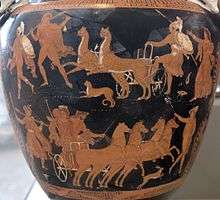
In some forms Hades appears with his chthonic horses. The myth of the abduction of Persephone was derived from the idea that Hades catches the souls of the dead and then carries them with his horses into his kingdom. This idea is vague in Homer, but appears in later Greek depictions, and in Greek folklore. "Charos" appears with his horse and carries the dead into the underworld.[54][55]
The cults of Persephone and Demeter in the Eleusinian mysteries and in the Thesmophoria were based on old agrarian cults.[56] A lot of ancient beliefs were based on initiation into jealously-guarded mysteries (secret rites) because they offered prospects after death more enjoyable than the final end at the gloomy space of the Greek Hades. There is evidence that some practices were derived from the religious practices of the Mycenaean age.[57][53] Kerenyi asserts that these religious practices were introduced from Minoan Crete.,[58][59] The idea of immortality which appears in the syncretistic religions of the Near East did not exist in the Eleusinian mysteries at the very beginning.[60][61]
In the Near East and Minoan Crete

In the Near eastern myth of the early agricultural societies, every year the fertility goddess bore the "god of the new year", who then became her lover, and died immediately in order to be reborn and face the same destiny. Some findings from Catal Huyuk since the Neolithic age, indicate the worship of the Great Goddess accompanied by a boyish consort, who symbolizes the annual decay and return of vegetation.[62] Similar cults of resurrected gods appear in the Near East and Egypt in the cults of Attis, Adonis and Osiris.[63]
In Minoan Crete, the "divine child" was related to the female vegetation divinity Ariadne who died every year.[64] The Minoan religion had its own characteristics. The most peculiar feature of the Minoan belief in the divine, is the appearance of the goddess from above in the dance. Dance floors have been discovered in addition to "vaulted tombs", and it seems that the dance was ecstatic. Homer memorializes the dance floor which Daedalus built for Ariadne in the remote past.[65] On the gold ring from Isopata, four women in festal attire are performing a dance between blossoming flowers. Above a figure apparently floating in the air seems to be the goddess herself, appearing amid the whirling dance.[66] An image plate from the first palace of Phaistos, seems to be very close to the mythical image of the Anodos (ascent) of Persephone. Two girls dance between blossoming flowers, on each side of a similar but armless and legless figure which seems to grow out of the ground. The goddess is bordered by snake lines which give her a vegetable like appearance She has a large stylized flower turned over her head. The resemblance with the flower-picking Persephone and her companions is compelling.[53] The depiction of the goddess is similar to later images of "Anodos of Pherephata". On the Dresden vase, Persephone is growing out of the ground, and she is surrounded by the animal-tailed agricultural gods Silenoi.[67]
Kerenyi suggests that the name Ariadne (derived from ἁγνή, hagne, "pure"), was an euphemistical name given by the Greeks to the nameless "Mistress of the labyrinth" who appears in a Mycenean Greek inscription from Knossos in Crete. The Greeks used to give friendly names to the deities of the underworld. Cthonic Zeus was called Eubuleus, "the good counselor", and the ferryman of the river of the underworld Charon, "glad".[55] Despoina and "Hagne" were probably euphemistic surnames of Persephone, therefore he theorizes that the cult of Persephone was the continuation of the worship of a Minoan Great goddess. The labyrinth was both a winding dance-ground and, in the Greek view, a prison with the dreaded Minotaur at its centre.[68][69] It is possible that some religious practices, especially the mysteries, were transferred from a Cretan priesthood to Eleusis, where Demeter brought the poppy from Crete.[70] Besides these similarities, Burkert explains that up to now it is not known to what extent one can and must differentiate between Minoan and Mycenean religion.[71] In the Anthesteria Dionysos is the "divine child".
In Mycenaean Greece
There is evidence of a cult in Eleusis from the Mycenean period;[72] however, there are not sacral finds from this period. The cult was private and there is no information about it. As well as the names of some Greek gods in the Mycenean Greek inscriptions, also appear names of goddesses, like "the divine Mother" (the mother of the gods) or "the Goddess (or priestess) of the winds", who don't have Mycenean origin .[52] In historical times, Demeter and Kore were usually referred to as "the goddesses" or "the mistresses" (Arcadia) in the mysteries .[73] In the Mycenean Greek tablets dated 1400–1200 BC, the "two queens and the king" are mentioned. John Chadwick believes that these were the precursor divinities of Demeter, Persephone and Poseidon.[74][75]
Some information can be obtained from the study of the cult of Eileithyia at Crete, and the cult of Despoina. In the cave of Amnisos at Crete, Eileithyia is related with the annual birth of the divine child and she is connected with Enesidaon (The earth shaker), who is the chthonic aspect of the god Poseidon.[76] Persephone was conflated with Despoina, "the mistress", a chthonic divinity in West-Arcadia.[59] The megaron of Eleusis is quite similar with the "megaron" of Despoina at Lycosura.[52] Demeter is united with her, the god Poseidon, and she bears him a daughter, the unnameable Despoina.[77] Poseidon appears as a horse, as it usually happens in Northern European folklore. The goddess of nature and her companion survived in the Eleusinian cult, where the following words were uttered "Mighty Potnia bore a great sun".[76] In Eleusis, in a ritual, one child ("pais") was initiated from the hearth. The name pais (the divine child) appears in the Mycenean inscriptions,[52] and the ritual indicates the transition from the old funerary practices to the Greek cremation.[78]
In Greek mythology Nysa is a mythical mountain with an unknown location.[51] Nysion (or Mysion), the place of the abduction of Persephone was also probably a mythical place which did not exist on the map, a magically distant chthonic land of myth which was intended in the remote past.[79]
The Thesmophoria

Thesmophoria, were celebrated in Athens, and the festival was widely spread in Greece. This was a festival of secret women-only rituals connected with marriage customs and commemorated the third of the year, in the month Pyanepsion, when Kore was abducted and Demeter abstained from her role as goddess of harvest and growth. The ceremony involved sinking sacrifices into the earth by night and retrieving the decaying remains of pigs that had been placed in the megara of Demeter (trenches and pits or natural clefts in rock), the previous year. These were placed on altars, mixed with seeds, then planted.[80] Pits rich in organic matter at Eleusis have been taken as evidence that the Thesmophoria was held there as well as in other demes of Attica.[81] This agrarian magic was also used in the cult of the earth-goddesses potniai (mistresses) in the Cabeirian, and in Knidos.[82]
The festival was celebrated over three days. The first was the "way up" to the sacred space, the second, the day of feasting when they ate pomegranate seeds and the third was a meat feast in celebration of Kalligeneia a goddess of beautiful birth. Zeus penetrated the mysteries as Zeus- Eubuleus[80] which is an euphemistical name of Hades (Chthonios Zeus).[22] In the original myth which is an etiology for the ancient rites, Eubuleus was a swineherd who was feeding his pigs at the opening to the underworld when Persephone was abducted by Plouton. His swine were swallowed by the earth along with her.[35]
The Eleusinian mysteries
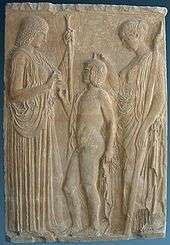
The Eleusinian mysteries was a festival celebrated at the autumn sowing in the city of Eleusis. Inscriptions refer to "the Goddesses" accompanied by the agricultural god Triptolemos (probably son of Ge and Oceanus),[83] and "the God and the Goddess" (Persephone and Plouton) accompanied by Eubuleus who probably led the way back from the underworld.[84] The myth was represented in a cycle with three phases: the "descent", the "search", and the "ascent", with contrasted emotions from sorrow to joy which roused the mystae to exultation. The main theme was the ascent of Persephone and the reunion with her mother Demeter.[43] The festival activities included dancing, probably across the Rharian field, where according to the myth the first grain grew.
At the beginning of the feast, the priests filled two special vessels and poured them out, the one towards the west, and the other towards the east. The people looking both to the sky and the earth shouted in a magical rhyme "rain and conceive". In a ritual, a child was initiated from the hearth (the divine fire). It was the ritual of the "divine child" who originally was Ploutos. In the Homeric hymn the ritual is connected with the myth of the agricultural god Triptolemos[78] The high point of the celebration was "an ear of grain cut in silence", which represented the force of the new life. The idea of immortality didn't exist in the mysteries at the beginning, but the initiated believed that they would have a better fate in the underworld. Death remained a reality, but at the same time a new beginning like the plant which grows from the buried seed.[52] In the earliest depictions Persephone is an armless and legless deity, who grows out of the ground.[53]
In Rome
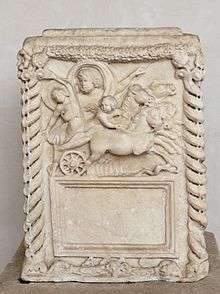
The Romans first heard of her from the Aeolian and Dorian cities of Magna Graecia, who used the dialectal variant Proserpinē (Προσερπίνη). Hence, in Roman mythology she was called Proserpina, a name erroneously derived by the Romans from proserpere, "to shoot forth"[85] and as such became an emblematic figure of the Renaissance.[86] In 205 BC, Rome officially identified Proserpina with the local Italic goddess Libera, who, along with Liber, were strongly associated with the Roman grain goddess Ceres (considered equivalent to the Greek Demeter). The Roman author Gaius Julius Hyginus also considered Proserpina equivalent to the Cretan goddess Ariadne, who was the bride of Liber's Greek equivalent, Dionysus.[87][88]
In Magna Graecia
At Locri, a city of Magna Graecia situated on the coast of the Ionian Sea in Calabria (southern Italy), perhaps uniquely, Persephone was worshiped as protector of marriage and childbirth, a role usually assumed by Hera; in the iconography of votive plaques at Locri, her abduction and marriage to Hades served as an emblem of the marital state, children at Locri were dedicated to Proserpina, and maidens about to be wed brought their peplos to be blessed.[89] Diodorus Siculus knew the temple there as the most illustrious in Italy.[90] During the 5th century BC, votive pinakes in terracotta were often dedicated as offerings to the goddess, made in series and painted with bright colors, animated by scenes connected to the myth of Persephone. Many of these pinakes are now on display in the National Museum of Magna Græcia in Reggio Calabria. Locrian pinakes represent one of the most significant categories of objects from Magna Graecia, both as documents of religious practice and as works of art.[91]
The temple at Lorci was looted by Pyrrhus.[92] The importance of the regionally powerful Lokrian Persephone influenced the representation of the goddess in Magna Graecia. Pinakes, terracotta tablets with brightly painted sculptural scenes in relief were founded in Locri. The scenes are related to the myth and cult of Persephone and other deities. They were produced in Locri during the first half of the 5th century BC and offered as votive dedications at the Locrian sanctuary of Persephone. More than 5,000, mostly fragmentary, pinakes are stored in the National Museum of Magna Græcia in Reggio Calabria and in the museum of Locri.[91] Representations of myth and cult on the clay tablets (pinakes) dedicated to this goddess reveal not only a 'Chthonian Queen,’ but also a deity concerned with the spheres of marriage and childbirth.[90]
The Italian archaeologist Paolo Orsi, between 1908 and 1911, carried out a meticulous series of excavations and explorations in the area which allowed him to identify the site of the renowned Persephoneion, an ancient temple dedicated to Persephone in Calabria which Diodorus in his own time knew as the most illustrious in Italy.[93]
The place where the ruins of the Sanctuary of Persephone were brought to light is located at the foot of the Mannella hill, near the walls (upstream side) of the polis of Epizephyrian Locri. Thanks to the finds that have been retrieved and to the studies carried on, it has been possible to date its use to a period between the 7th century BC and the 3rd century BC.
Archaeological finds suggest that worship of Demeter and Persephone was widespread in Sicily and Greek Italy.
In Orphism
Evidence from both the Orphic Hymns and the Orphic Gold Leaves demonstrate that Persephone was one of the most important deities worshiped in Orphism.[94] In the Orphic religion, gold leaves with verses intended to help the deceased enter into an optimal afterlife were often buried with the dead. Persephone is mentioned frequently in these tablets, along with Demeter and Euklês, which may be another name for Plouton.[94] The ideal afterlife destination believers strive for is described on some leaves as the "sacred meadows and groves of Persephone". Other gold leaves describe Persephone's role in receiving and sheltering the dead, in such lines as "I dived under the kolpos [portion of a Peplos folded over the belt] of the Lady, the Chthonian Queen", an image evocative of a child hiding under their mother's apron.[94]
In Orphism, Persephone is believed to be the mother of the first Dionysus. In Orphic myth, Zeus came to Persephone in her bedchamber in the underworld and impregnated her with the child who would become his successor. The infant Dionysus was later dismembered by the Titans, before being reborn as the second Dionysus, who wandered the earth spreading his mystery cult before ascending to the heavens with his second mother, Semele.[95] The first, "Orphic" Dionysus is sometimes referred to with the alternate name Zagreus (Greek: Ζαγρεύς). The earliest mentions of this name in literature describe him as a partner of Gaia and call him the highest god. The Greek poet Aeschylus considered Zagreus either an alternate name for Hades, or his son (presumably born to Persephone).[96] Scholar Timothy Gantz noted that Hades was often considered an alternate, cthonic form of Zeus, and suggested that it is likely Zagreus was originally the son of Hades and Persephone, who was later merged with the Orphic Dionysus, the son of Zeus and Persephone, owing to the identification of the two fathers as the same being.[97] However, no known Orphic sources use the name "Zagreus" to refer to Dionysus. It is possible that the association between the two was known by the 3rd century BC, when the poet Callimachus may have written about it in a now-lost source.[98]
Other local cults
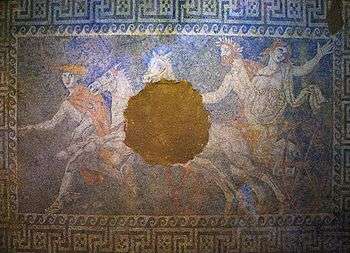

_(12853680765).jpg)
Local cults of Demeter and Kore existed in Greece, Asia Minor, Sicily, Magna Graecia, and Libya.
- Attica:[99]
- Athens, in the mysteries of Agrae. This was a local cult near the river Ilissos. They were celebrated during spring in the month Anthesterion. Later they became an obligation for the participants of the "greater" Eleusinian mysteries. There was a temple of Demeter and Kore and an image of Triptolemos.[100]
- Piraeus: The Skirophoria, a festival related to the Thesmophoria.
- Megara: Cult of Demeter thesmophoros and Kore. The city was named after its megara .[101]
- Aegina: Cult of Demeter thesmophoros and Kore.
- Phlya, near Koropi, in the mysteries of Phlya: These have very old roots and were probably originally dedicated to Demeter Anesidora, Kore, and Zeus Ktesios, who was the god of the underground stored grain. Pausanias mentions a temple of Demeter-Anesidora, Kore Protogone, and Zeus Ktesios. The surname Protogonos, indicates a later Orphic influence. It seems that the mysteries were related to the mysteries of Andania in Messene.[102]
- Boeotia:
- Thebes, which Zeus is said to have given to her as an acknowledgement for a favour she had bestowed upon him.[103] Pausanias records a grove of Cabeirian Demeter and the Maid, three miles outside the gates of Thebes, where a ritual was performed, so-called on the grounds that Demeter gave it to the Cabeiri, who established it at Thebes. The Thebans told Pausanias that some inhabitants of Naupactus had performed the same rituals there, and had met with divine vengeance.[104] The Cabeirian mysteries were introduced from Asia Minor at the end of the archaic period. Nothing is known of the older cult, and it seems that the Cabeiri were originally wine-daemons. Inscriptions from the temple in Thebes mention the old one as Cabir, and the new one as son (pais), who are different.[102] According to Pausanias, Pelarge, the daughter of Potnieus, was connected with the cult of Demeter in the Cabeirian (potniai).[82]
- A feast in Boeotia, in the month Demetrios (Pyanepsion), probably similar with the Thesmophoria.
- Thebes: Cult of Demeter and Kore in a feast named Thesmophoria but probably different. It was celebrated in the summer month Bukatios.[26][105]
- Peloponnese (except Arcadia)[26]
- Hermione: An old cult of Demeter Chthonia, Kore, and Klymenos (Hades). Cows were pushed into the temple, and then they were killed by four women. It is possible that Hermione was a mythical name, the place of the souls.[22]
- Asine: Cult of Demeter Chthonia. The cult seems to be related to the original cult of Demeter in Hermione.[22]
- Lakonia: Temple of Demeter Eleusinia near Taygetos. The feast was named Eleuhinia, and the name was given before the relation of Demeter with the cult of Eleusis.
- Lakonia at Aigila: Dedicated to Demeter. Men were excluded.
- near Sparta: Cult of Demeter and Kore, the Demeters (Δαμάτερες, "Damaters"). According to Hesychius, the feast lasted three days (Thesmophoria).
- Corinth: Cult of Demeter, Kore, and Pluton.[22]
- Triphylia in Elis: Cult of Demeter, Kore, and Hades.[22]
- Pellene: Dedicated to the Mysian Demeter. Men were excluded. The next day, men and women became naked.
- Andania in Messenia (near the borders of Arcadia): Cult of the Great goddesses, Demeter and Hagne. Hagne, a goddess of the spring, was the original deity before Demeter. The temple was built near a spring.
- Arcadia[27]
- Pheneos : Mysteries of Demeter Thesmia and Demeter Eleusinia. The Eleusinian cult was introduced later. The priest took the holy book from a natural cleft. He used the mask of Demeter Kidaria, and he hit his stick on the earth, in a kind of agrarian magic. An Arcadian dance was named kidaris.
- Pallantion near Tripoli: Cult of Demeter and Kore.
- Karyai: Cult of Kore and Pluton.[22]
- Tegea: Cult of Demeter and Kore, the Karpophoroi, "Fruit givers".
- Megalopolis: Cult of the Great goddesses, Demeter and Kore Sotira, "the savior".
- Mantineia: Cult of Demeter and Kore in the fest Koragia.[106]
- Trapezus: Mysteries of the Great goddesses, Demeter and Kore. The temple was built near a spring, and a fire was burning out of the earth.
- near Thelpusa in Onkeion: Temple of Demeter Erinys (vengeful) and Demeter Lusia (bathing). In the myth Demeter was united with Poseidon Hippios (horse), and bore him the horse Arion and the unnamed. The name Despoina was given in West Arcadia.
- Phigalia: Cult of the mare-headed Demeter (black), and Despoina. Demeter was depicted in her archaic form, a Medusa type with a horse's head with snaky hair, holding a dove and a dolphin.[107] The temple was built near a spring.
- Lycosura, Cult of Demeter and Despoina. In the portico of the temple of Despoina there was a tablet with the inscriptions of the mysteries. In front of the temple there was an altar to Demeter and another to Despoine, after which was one of the Great Mother. By the sides stood Artemis and Anytos, the Titan who brought up Despoine. Besides the temple, there was also a hall where the Arcadians celebrated the mysteries[108][109] A fire was always burning in front of the temple of Pan (the goat-god), the god of the wild, shepherds and flocks. In a relief appear dancing animal-headed women (or with animal-masks) in a procession. Near the temple have been found terracotta figures with human bodies, and heads of animals.[27]
- Islands
- Paros: Cult of Demeter, Kore, and Zeus-Eubuleus.[22]
- Amorgos: Cult of Demeter, Kore, and Zeus-Eubuleus.[22]
- Delos: Cult of Demeter, Kore, and Zeus-Eubuleus. Probably a different feast with the name Thesmophoria, celebrated in a summer month (the same month in Thebes). Two big loaves of bread were offered to the two goddesses. Another feast was named Megalartia.[26][105]
- Mykonos: Cult of Demeter, Kore, and Zeus-Buleus.
- Crete : Cult of Demeter and Kore, in the month Thesmophorios.
- Rhodes: Cult of Demeter and Kore, in the month Thesmophorios. The two goddesses are the Damaters in an inscription from Lindos
- Egypt
- Alexandria: According to Epiphanius, a temple of Kore existed in Alexandria. He describes a celebration of the birth of Aion from Kore the Virgin which took place there on 6 January. During the ceremony, a wood statue of Aion, marked with gold-inlaid crosses on his hands, knees, and forehead, was brought up from an underground vault and processed through the temple. A feast would follow, after which the icon was returned to the vault.[110] Epiphanius noted that the celebration coincided with Aion's birth: "On this day and at this hour, Kore gave birth to Aion." The date, which coincides with the Christian feast of the Epiphany, brought new year's celebrations to a close.[111] Aion may be a form of Dionysus, reborn annually;[112] an inscription from Eleusis also identifies Aion as a son of Kore.[113]
- Asia Minor
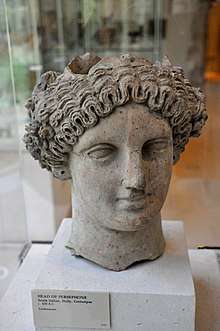
Ancient literary references
- Homer:
- Iliad:
- "the gods fulfilled his curse, even Zeus of the nether world and dread Persephone." (9, line 457; A. T. Murray, trans)
- "Althea prayed instantly to the gods, being grieved for her brother's slaying; and furthermore instantly beat with her hands upon the all-nurturing earth, calling upon Hades and dread Persephone" (9, 569)
- Odyssey:
- "And come to the house of Hades and dread Persephone to seek sooth saying of the spirit of Theban Teiresias. To him even in death Persephone has granted reason that ..." (book 10, card 473)
- Iliad:
- Hymns to Demeter[116]
- Hymn 2:
- "Mistress Demeter goddess of heaven, which God or mortal man has rapt away Persephone and pierced with sorrow your dear heart?(hymn 2, card 40)
- Hymn 13:
- "I start to sing for Demeter the lovely-faced goddess, for her and her daughter the most beautiful Persephone. Hail goddess keep this city safe!" (hymn 13, card 1)
- Hymn 2:
- Pindar[116]
- Olympian:
- "Now go Echo, to the dark-walled home of Persephone."(book O, poem 14)
- Isthmean:
- "Aecus showed them the way to the house of Persephone and nymphs, one of them carrying a ball."(book 1, poem 8)
- Nemean:
- "Island which Zeus, the lord of Olympus gave to Persephone;he nodded descent with his flowers hair."(book N, poem 1)
- Pythian:
- "You splendor-loving city, most beautiful on earth, home of Persephone. You who inhabit the hill of well-built dwellings."(book P, poem 12)
- Olympian:
- Aeschylus[116]
- Libation bearers:
- Electra:"O Persephone, grant us indeed a glorious victory!" (card 479)
- Libation bearers:
- Aristophanes[116]
- Thesmophoriazusae:
- Mnesilochos:"Thou Mistress Demeter, the most valuable friend and thou Persephone, grant that I may be able to offer you!" (card 266)
- Thesmophoriazusae:
- Euripides[116]
- Alcestis:
- "O you brave and best hail, sitting as attendand Beside's Hades bride Persephone!" (card 741)
- Hecuba:
- "It is said that any of the dead that stand beside Persephone, that the Danaids have left the plains to Troy." (card 130)
- Alcestis:
- Bacchylides[116]
- Epinicians:
- "Flashing thunderbolt went down to the halls of slender-ankled Persephone to bring up into the light of Hades." (book Ep. poem 5)
- Epinicians:
- Vergil[117]
- The Aeneid:
- "For since she had not died through fate, or by a well-earned death, but wretchedly, before her time, inflamed with sudden madness, Proserpine had not yet taken a lock of golden hair from her head, or condemned her soul to Stygian Orcus." (IV.696–99)
- The Aeneid:
Modern reception
Persephone also appears many times in popular culture. Featured in a variety of young adult novels such as Persephone[118] by Kaitlin Bevis, Persephone's Orchard[119] by Molly Ringle, The Goddess Test by Aimee Carter, The Goddess Letters by Carol Orlock, Abandon by Meg Cabot, and Lore Olympus by Rachel Smythe, her story has also been treated by Suzanne Banay Santo in Persephone Under the Earth in the light of women's spirituality. Here Santo treats the mythic elements in terms of maternal sacrifice to the burgeoning sexuality of an adolescent daughter. Accompanied by the classic, sensual paintings of Frederic Lord Leighton and William-Adolphe Bouguereau, Santo portrays Persephone not as a victim but as a woman in quest of sexual depth and power, transcending the role of daughter, though ultimately returning to it as an awakened Queen.[120]
See also
- Anthesphoria, festival honoring Proserpina, and Persephon
- Eleusinian Mysteries
- Rape of Persephone
- Sporus
Notes
- The actual word in Linear B is 𐀟𐀩𐁚, pe-re-*82 or pe-re-swa; it is found on the PY Tn 316 tablet.[3]
- Empedocles was a Greek pre-Socratic philosopher who was a citizen of Agrigentum, a Greek colony in Sicily.
- Kingsley 1995 identifies Nestis as a cult title of Persephone.
- In art the abduction of Persephone is often referred to as the "Rape of Persephone", where "rape" is the traditional translation of the Latin raptus, "seized" or "carried off", and does not refer specifically to sexual violence. This is the same sense used in the "Rape of the Sabine Women".
- Hom. Hymn. to Demeter 470:
"Awful mysteries which no one may in any way transgress or pry into or utter, for deep awe of the gods checks the voice. Happy is he among men upon earth who has seen these mysteries; but he who is uninitiate and who has no part in them, never has lot of like good things once he is dead, down in the darkness and gloom". - "This is the time when Zeus mated with Semele, who is also Persephone, and Dionysos was conceived. It is also the time when Dionysos took Ariadne to be His wife, and so we celebrate the marriage of the Basilinna (religious Queen) and the God". [41]
References
- Martin Nilsson (1967). Die Geschichte der Griechische Religion Vol I pp 462–463, 479–480
- Fraser. The golden bough. Adonis, Attis and Osiris. Martin Nilsson (1967). Vol I, pp. 215
- Raymoure, K.A. "pe-re-*82". Minoan Linear A & Mycenaean Linear B. Deaditerranean. "PY 316 Tn (44)". DĀMOS: Database of Mycenaean at Oslo. University of Oslo.
- Chadwick, John (1976). The Mycenaean World. Cambridge, UK: Cambridge University Press. p. 95. ISBN 0-521-29037-6. At Google Books.
- Comments about the goddess pe-re-*82 of Pylos tablet Tn 316, tentatively reconstructed as *Preswa
- "It is tempting to see ... the classical Perse ... daughter of Oceanus ... ; whether it may be further identified with the first element of Persephone is only speculative." John Chadwick. Documents in Mycenean Greek. Second Edition
- Homer (1899). Odyssey. Clarendon Press. p. 230. Retrieved 31 March 2014.
- H.G. Liddell and R. Scott, A Greek-English Lexicon
- Martin P. Nilsson (1967), Die Geschichte der Griechische Religion, Volume I, C.F. Beck Verlag, p. 474.
- R. S. P. Beekes, Etymological Dictionary of Greek, Brill, 2009, pp. 1179–80.
- Smith, "Perse'phone"
- Plutarch, Moralia (On Isis and Osiris, Ch. 69)
- Orphic Hymn 29.16
- Schol. ad. Theocritus 2.12
- In the Hymn to Melinoe, where the father is Zeus Chthonios, either Zeus in his chthonic aspect, or Pluto; Radcliffe G. Edmonds III, "Orphic Mythology," in A Companion to Greek Mythology (Blackwell, 2011), p. 100.
- Pausanias, Description of Greece (Book 8, Ch. 37, sect. 9)"
- Pseudo-Apollodorus, Bibliotheca (Book 1, Ch. 3).
- Gantz, p. 64; Homer, Odyssey (Book 10, ln. 494).
- Orphic Hymn 26, 71
- Homer, Odyssey (Book 10, ln. 491; Book 10, ln. 509).
- Károly Kerényi, Eleusis: Archetypal Image of Mother and Daughter, 1967, passim
- Peter Kingsley, in Ancient Philosophy, Mystery, and Magic: Empedocles and Pythagorean Tradition (Oxford University Press, 1995).
- Rhode (1961), Psyche I, pp. 206–210
- Nilsson (1967) Vol I, pp. 478–480
- Orphic Hymn 29 to Persephone
- "PERSEPHONE - Greek Goddess of Spring, Queen of the Underworld (Roman Proserpina)".
- Nilsson (1967) Vol I, pp. 463–466
- Nilsson, pp. 477–480 :"The Arcadian Great goddesses"
- Pausanias.Description of Greece 5.15.4, 5, 6
- Hesiod, Theogony 914.
- Homeric Hymn to Demeter, 4–20, 414–434.
- "Theoi Project - Persephone". Theoi.com. Retrieved 6 July 2012.
- The Homeric Hymn to Demeter, 411–412, has Persepjone say: "but he secretly put in my mouth sweet food, a pomegranate seed, and forced me to taste against my will.".
- Gantz, p. 65.
- Gantz, p. 67.
- Reference to the Thesmophoria in Lucian's Dialogues of the Courtesans 2.1.
- The figures are unmistakable, as they are inscribed "Persophata, Hermes, Hekate, Demeter"; Gisela M. A. Richter, "An Athenian Vase with the Return of Persephone" The Metropolitan Museum of Art Bulletin 26.10 (October 1931:245–248)
- Suidas s.v. Makariai, with English translation at Suda On Line, Adler number mu 51
- William Hansen (2005) Classical Mythology: A Guide to the Mythical World of the Greeks and Romans (Oxford University Press, 2005), pp. 180–182.
- Hansen, Classical Mythology, p. 182.
- Ap. Athanassakis (2004), Hesiod. Theogony, Works and Days, Shield ,Johns Hopkins University Press, p. 56.
- The Anthesteria Archived 20 August 2007 at the Wayback Machine Bibliotheca Arcana (1997)
- Martin Nilsson (1967). Vol I, pp. 215–219
- "Martin Nilsson, The Greek popular religion, The religion of Eleusis, pp 51-54". Sacred-texts.com. 8 November 2005. Retrieved 6 July 2012.
- Martin Nilsson (1967) Vol I, pp. 473–474.
- Pausanias 2.30.2
- Nilsson, VoI, p. 444
- Burkert (1985), pp. 285–289
- Kramer, Samuel Noah. Sumerian Mythology: A Study of Spiritual and Literary Achievement in the Third Millennium B.C.: Revised Edition. University of Pennsylvania Press, 1961, Philadelphia. ISBN 0-8122-1047-6 (Pages 76-79) available at sacred-texts.com. "Moreover, the crime involved is probably that of abducting a goddess; it therefore brings to mind the Greek story of the abduction of Persephone."
- Homeric Hymn to Demeter, 17.
- Nilsson (1967), Vol I, p. 463
- "In Greek mythology Nysa is a mythical mountain with unknown location, the birthplace of the god Dionysos.": Fox, William Sherwood (1916), The Mythology of All Races, v.1, Greek and Roman, General editor, Louis Herbert Gray, p.217
- Burkert (1985), pp. 285–290.
- Burkert (1985) p. 42
- Martin Nilsson (1967) Vol I, pp. 453–455
- Charon, "glad", probably euphemistically "death". Liddell and Scott, A Greek-English Lexicon (Oxford: Clarendon Press 1843, 1985 printing), entries on χαροπός and χάρων, pp. 1980–1981; Brill's New Pauly (Leiden and Boston 2003), vol. 3, entry on "Charon", pp. 202–203.
- Nilsson, Vol I, p.470
- Dietrich "The origins of the Greek Religion" p.220,221
- "Kerenyi (1976), Dionysos, archetypal image of indestructible life.Princeton University Press. p. 24
- Karl Kerenyi (1967). Eleusis. Archetypal image of mother and daughter. Princeton University Press. p. 31f
- Burkert (1985) p. 289
- "According to the Greek popular belief,ἕν ἀνδρῶν, ἕν θεῶν γένος".(One is the nature of men, another one the nature of gods): Erwin Rhode (1961), Psyche Band I, p. 293
- Burkert p.12
- J.Frazer The Golden Bough, Part IV, Adonis, Attis and Osiris
- F.Schachermeyer (1972), Die Minoische Kultur des alten Kreta, Stuttgart: Kohlhammer Verlag, pp. 141, 308
- Burkert (1985) pp. 34–40
- Burkert (1985) p. 40
- "Hermes and the Anodos of Pherephata": Nilsson (1967) p. 509 taf. 39,1
- Karl Kerenyi (1976), Dionysos: archetypal image of indestructible life, pp. 89, 90 ISBN 0-691-02915-6
- Hesychius, listing of ἀδνόν, a Cretan-Greek form for ἁγνόν, "pure"
- Kerenyi(1976), p.24
- "To what extent one can and must differentiate between Minoan and Mycenaean religion is a question which has not yet found a conclusive answer" :.Burkert (1985). p. 21.
- G. Mylonas (1932). Eleusiniaka. I,1 ff
- Nilsson (1967), pp. 463–465
- John Chadwick (1976).The Mycenean World. Cambridge University Press
- "Wa-na-ssoi, wa-na-ka-te, (to the two queens and the king). Wanax is best suited to Poseidon, the special divinity of Pylos. The identity of the two divinities addressed as wanassoi, is uncertain ": George Mylonas (1966) Mycenae and the Mycenean age" p. 159 : Princeton University Press
- Dietrich p. 220,221
- "Pausanias 8.37.9". Perseus.tufts.edu. Retrieved 6 July 2012.
- "In Greek mythology Achileus becomes immortal by the divine fire. His heel was his only mortal element, because it was not touched by the fire : Wunderlich (1972), The secret of Crete p. 134
- Nilsson, Vol I p. 463
- Burkert (1985), pp. 240–243
- Clinton, Greek Sanctuaries, p. 113.
- Potniai: Pelarge daughter of Potnieus is connected with the cult of Demeter in the Cabeirian : Pausanias 9.25,8, Nilsson (1967) Vol I pp. 151, 463
- Pseudo Apollodorus Biblioteca IV.2
- Kevin Klinton (1993), Greek Sanctuaries: New Approaches, Routledge, p. 11
- Cicero. De Natura Deorum 2.26
- Welch (2013), p. 164
- T. P. Wiseman, "Satyrs in Rome? The Background to Horace's Ars Poetica", The Journal of Roman Studies, Vol. 78 (1988), p 7, note 52.
- Barbette Stanley Spaeth, The Roman goddess Ceres, University of Texas Press, 1996
- Christiane Sourvinou-Inwood, "Persephone" The Journal of Hellenic Studies 98 (1978:101–121).
- Eisenfeld, Hanne (1 October 2016). "Life, Death, and a Lokrian Goddess. Revisiting the Nature of Persephone in the Gold Leaves of Magna Graecia". Kernos. Revue internationale et pluridisciplinaire de religion grecque antique (29): 41–72. doi:10.4000/kernos.2388 – via journals.openedition.org.
- Bennett, Michael; Bennett, Michael J.; Bennett, Professor of Palliative Medicine Michael; etc; Paul, Aaron J.; Iozzo, Mario; al, et; White, Bruce M.; Art, Cleveland Museum of; Art, Tampa Museum of (14 May 2019). "Magna Graecia: Greek Art from South Italy and Sicily". Hudson Hills – via Google Books.
- Livy: 29.8, 29.18
- "Locri Epizephyrii, The Archaeological Site - Persephoneion, the Sanctuary of Persephone". www.locriantica.it.
- Bremmer, J. N. (2013). Divinities in the Orphic Gold Leaves: Euklês, Eubouleus, Brimo, Kybele, Kore and Persephone. Zeitschrift für Papyrologie und Epigraphik, 35-48.
- Edmonds, R.G. III. (2011). Orphic Mythology. A Companion to Greek Mythology, First Edition. Edited by Ken Dowden and Niall Livingstone. Blackwell Publishing Ltd.
- Sommerstein, p. 237 n. 1; Gantz, p. 118; Smyth, p. 459.
- Gantz, p. 118.
- Gantz, pp. 118–119; West 1983, pp. 152–154; Linforth, pp. 309–311.
- Nilsson (1967) Vol I, pp. 463–465
- Pausanias 1.14,1: Nilsson (1967), Vol I, pp. 668–670
- Pausanias I 42,6 , Nilsson (1967), Vol I, p. 463
- Nilsson (1967), Vol I, pp. 668–670
- Scholia ad. Euripides Phoen. 487
- Pausanias 9.25.5
- Diodorus Siculus (v.4.7) :"At Thebes or Delos the festival occurred two months earlier, so any seed-sowing connection was not intrinsic."
- For Mantinea, see Brill's New Pauly "Persephone", II D.
- L. H. Jeffery (1976). Archaic Greece: The Greek city states c. 800–500 B.C (Ernest Benn Limited) p. 23 ISBN 0-510-03271-0
- "Pausanias 8.37.1,8.38.2". Theoi.com. Retrieved 6 July 2012.
- "Reconstruction of interior of Sanctuary of Despoina". Perseus.tufts.edu. Retrieved 6 July 2012.
- Fossum, "The Myth of the Eternal Rebirth," pp. 306–307.
- Gilles Quispel, "Hermann Hesse and Gnosis," in Gnostica, Judaica, Catholica: Collected Essays (Brill, 2008), p. 258; Gary Forsythe, Time in Roman Religion: One Thousand Years of Religious History (Routledge, 2012), p. 122.
- Fossum, "The Myth of the Eternal Rebirth," p. 309.
- Dittenberger: Sylloge Inscriptionum, 3rd ed., 1125
- Herodotus VI, 16: Nilsson (1967) ,Vol I, p. 464
- Brill's New Pauly, "Persephone", citing Diodorus 5.4
- "perseus tufts-persephone". Perseus.tufts.edu. Retrieved 6 July 2012.
- "Virgil: Aeneid IV". Poetryintranslation.com. Retrieved 6 July 2012.
- "Persephone (Daughters of Zeus, #1)".
- "Persephone's Orchard".
- Santo, Suzanne Banay (2012). Persephone Under the Earth. Red Butterfly Publications. ISBN 0-9880914-0-2.
Sources
- Apollodorus, Apollodorus, The Library, with an English Translation by Sir James George Frazer, F.B.A., F.R.S. in 2 Volumes, Cambridge, MA, Harvard University Press; London, William Heinemann Ltd. 1921.
- Bowra Maurice (1957), The Greek experience. The World Publishing Company, Cleveland and New York.
- Burkert Walter (1985). Greek Religion. Harvard University Press . ISBN 0-674-36281-0
- Farnell, Lewis Richard (1906), The Cults of the Greek States, Volume 3 (Chapters on: Demeter and Kore-Persephone; Cult-Monuments of Demeter-Kore; Ideal Types of Demeter-Kore).
- Gantz, Early Greek Myth: A Guide to Literary and Artistic Sources, Johns Hopkins University Press, 1996, Two volumes: ISBN 978-0-8018-5360-9 (Vol. 1), ISBN 978-0-8018-5362-3 (Vol. 2).
- Homer, The Iliad with an English Translation by A.T. Murray, Ph.D. in two volumes, Cambridge, MA., Harvard University Press; London, William Heinemann, Ltd. 1924.
- Homer, The Odyssey with an English Translation by A.T. Murray, PH.D. in two volumes. Cambridge, MA., Harvard University Press; London, William Heinemann, Ltd. 1919.
- Homeric Hymn to Demeter (2), in The Homeric Hymns and Homerica with an English Translation by Hugh G. Evelyn-White, Cambridge, Massachusetts, Harvard University Press; London, William Heinemann Ltd. 1914. Online version at the Perseus Digital Library.
- Janda, Michael (2010), Die Musik nach dem Chaos. Innsbruck
- Kerenyi Karl (1967), Eleusis: Archetypal image of mother and daughter . Princeton University Press.
- Kerenyi, Karl (1976), Dionysos: Archetypal Image of Indestructible Life, Princeton: Bollingen, Google Books preview
- Nilsson Martin (1967), Die Geschichte der Griechischen Religion, Vol I, C.F Beck Verlag, Muenchen. Revised ed.
- Nilsson Martin (1950), Minoan-Mycenaean Religion, and its Survival in Greek Religion, Lund:Gleerup. Revised 2nd ed.
- Pausanias, Pausanias Description of Greece with an English Translation by W.H.S. Jones, Litt.D., and H.A. Ormerod, M.A., in 4 Volumes, Cambridge, MA, Harvard University Press; London, William Heinemann Ltd. 1918.
- Rohde Erwin (1961), Psyche. Seelenkult und Unsterblichkeitsglaube der Griechen. Wissenschaftliche Buchgesellshaft. Darmstad. (First edition 1893): full text in German downloadable as pdf.
- Rohde Erwin (2000), Psyche: The Cult of Souls and the Belief in Immortality among the Greeks , trans. from the 8th edn. by W. B. Hillis (London: Routledge & Kegan Paul, 1925; reprinted by Routledge, 2000), online
- Schachermeyr Fritz (1964), Die Minoische Kultur des alten Kreta, W.Kohlhammer Verlag Stuttgart.
- Stephen King (2008), Duma Key
- Smith, William; Dictionary of Greek and Roman Biography and Mythology, London (1873). "Perse'phone"
- Anthony Welch (2013), The Renaissance Epic and the Oral Past. Yale University Press. ISBN 0300178867
- Zuntz Günther (1973), Persephone: Three Essays on Religion and Thought in Magna Graecia
External links
| Wikimedia Commons has media related to Persephone. |
| Look up persephone in Wiktionary, the free dictionary. |
- Martin Nilsson. The Greek popular religion
- Adams John Paul. Mycenean divinities
- Theoi project:Persephone Goddess
- Theoi project:The Rape of Persephone
- The Princeton Encyclopedia of classical sites:Despoina
- Theoi project:Despoine
- Kore Photographs
- Flickr users' photos tagged with Persephone
- Proserpine (Persephone) sculpture by Hiram Powers


